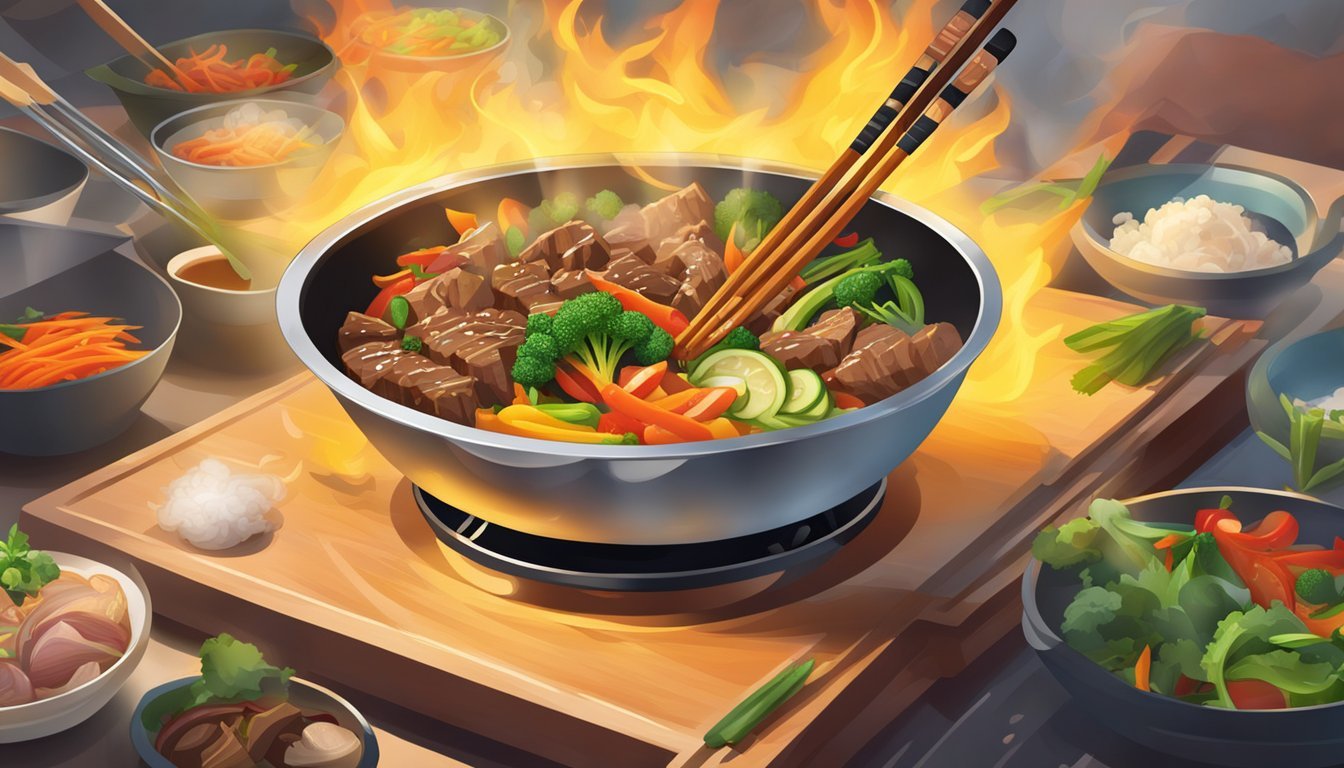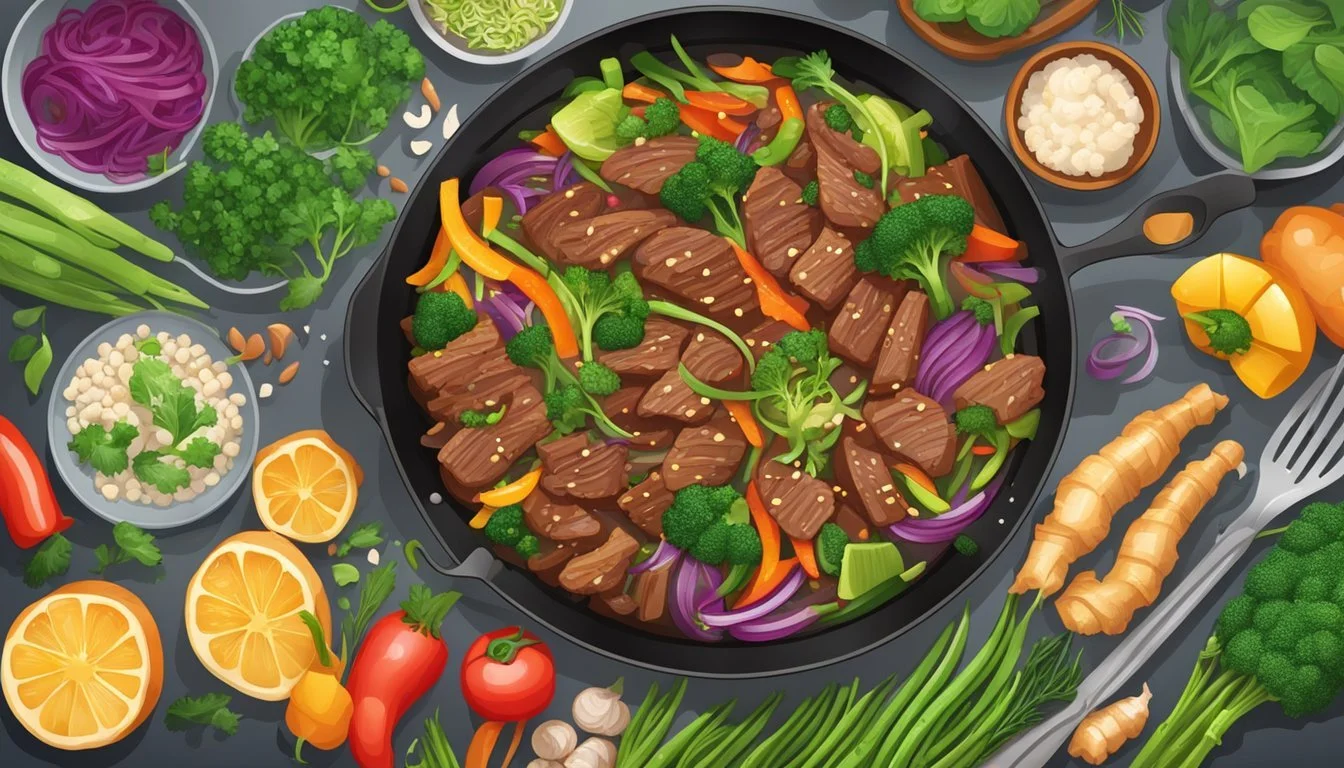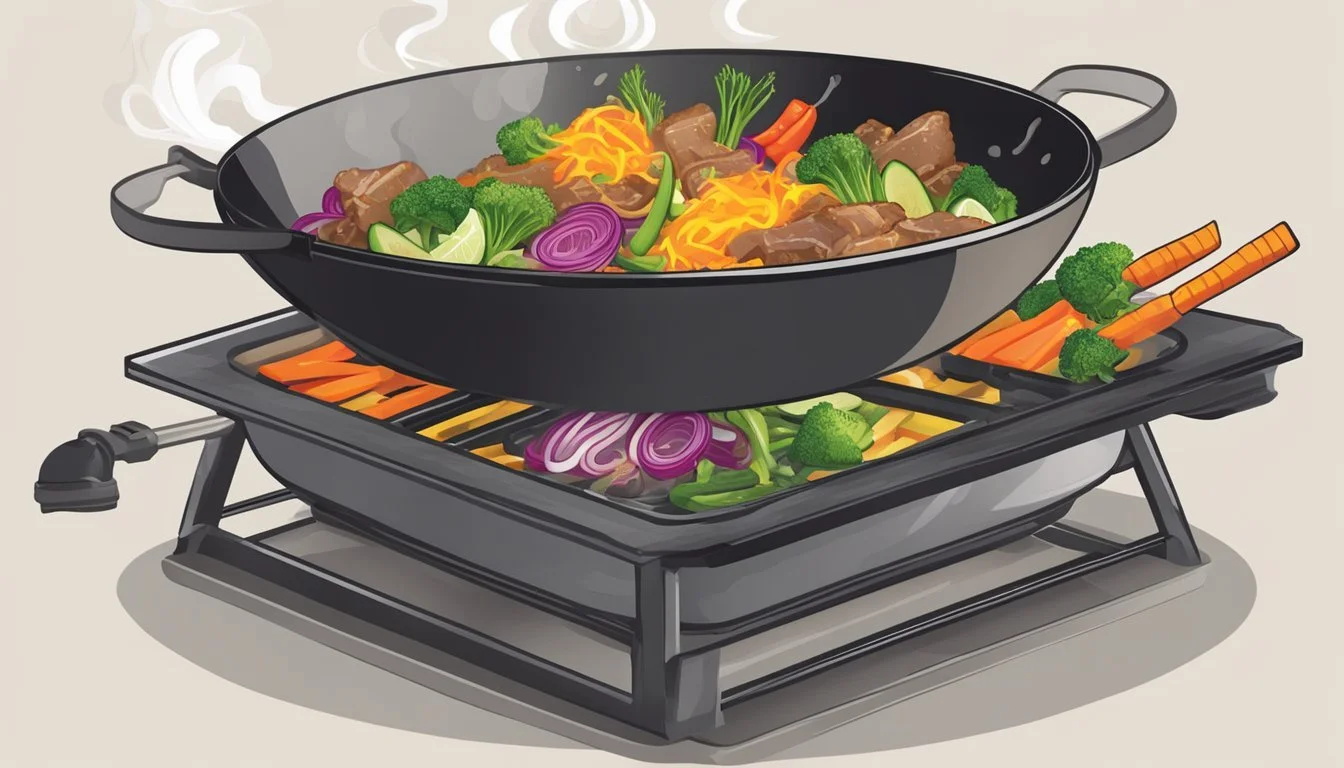How to Reheat Ginger Beef Stir-Fry for Perfect Flavor
Reheating ginger beef stir-fry can be a challenge if you want to retain its original flavors and textures. The key is to use methods that preserve the dish’s crispy and savory elements while ensuring the beef remains tender. To achieve the best results, reheating in an air fryer or oven is recommended.
Another effective approach involves reheating in a skillet. This method allows for better control over heat distribution, ensuring that the beef and vegetables stay moist without becoming mushy. Using medium heat and stirring occasionally can help maintain the dish's integrity.
A microwave offers a quicker option but tends to compromise the texture. For those in a hurry, covering the stir-fry with a paper towel and reheating in short bursts can help keep elements from drying out.
Understanding Ginger Beef Stir-Fry
Ginger beef stir-fry is a flavorful dish that combines tender beef, vibrant vegetables, and a savory ginger-infused sauce.
Commonly, the beef is marinated in a mix of corn starch, baking soda, sesame oil, sugar, and soy sauce. This step ensures the meat stays tender and absorbs the seasonings.
Ingredients:
Beef: Typically thinly sliced for quick cooking.
Ginger: Fresh ginger root provides a pungent and aromatic flavor.
Vegetables: Often includes bell peppers, carrots, and mushrooms.
Sauce: A blend of soy sauce, garlic, and sugar is often used.
The stir-frying technique involves cooking the beef on medium-high heat in a preheated wok or pan. The vegetables are then added, followed by the sauce, ensuring each component is well coated and cooked through.
Key Seasonings and Flavorings:
Ginger: Both fresh and ground forms can be used.
Garlic: Adds depth to the overall flavor.
Soy Sauce: Provides a rich, savory taste.
Sesame Oil: Enhances the aroma and texture.
Ginger beef stir-fry is best enjoyed fresh, but it can also be effectively reheated to retain its original taste and texture.
Preparation Essentials Before Reheating
Preparing ginger beef stir-fry for reheating starts with proper storage to retain flavor and texture and ensuring the food is reheated safely.
Storage Techniques
Proper storage is essential for preserving the quality of ginger beef stir-fry as leftovers. Once the dish has cooled, transfer it to an airtight container. This helps maintain moisture and prevents contamination.
Store the airtight container in the fridge if you plan to eat it within a few days. For longer storage, place the container in the freezer. When freezing, portion the stir-fry into smaller quantities to make reheating easier and quicker.
Label each container with the date to keep track of how long the stir-fry has been stored. Generally, stir-fry should be consumed within 3-4 days if stored in the fridge and within 2-3 months if frozen.
Reheating Safety Tips
When reheating ginger beef stir-fry, following safety guidelines ensures the meal remains safe to eat. Always reheat leftovers to an internal temperature of 165°F (74°C). This ensures that any harmful bacteria are eliminated.
To maintain the dish’s moisture, add a small amount of water or broth before reheating. This helps prevent the beef and vegetables from drying out. It's important to stir the stir-fry halfway through the reheating process, whether using a microwave, stove, or oven, to ensure even heating.
Avoid reheating the food multiple times to reduce the risk of bacterial growth. Only reheat the amount you plan to consume, and promptly refrigerate any remaining portions.
Choosing the Right Reheating Method
Selecting an effective reheating method is essential to preserve the texture and taste of ginger beef stir-fry. Each method has its unique advantages, and the best option depends on your available appliances and desired outcome.
Microwave Reheating
Using a microwave is a fast option for reheating ginger beef stir-fry but can sometimes lead to uneven heating.
To reheat, place the stir-fry in a microwave-safe dish. Cover the dish with a microwave-safe lid or microwave-safe plastic wrap, leaving a small vent. Heat on medium power for 2-3 minutes, stirring halfway through.
Adding a tablespoon of water can help maintain the moisture of the beef and veggies. If needed, heat in additional 30-second intervals until warm.
Stovetop Reheating
Reheating on the stove helps retain the original texture of the ginger beef stir-fry. Use a non-stick skillet or wok for the best results.
First, add a tablespoon of oil to the skillet and heat over medium heat. Once the oil is hot but not smoking, add the stir-fry. Stir frequently, ensuring the beef and vegetables are evenly heated.
Adding a small amount of water or broth can help keep the stir-fry moist. Continue stirring for 5-7 minutes or until the dish is thoroughly warm.
Oven Reheating
Reheating in the oven is ideal if you want to heat a large quantity of stir-fry at once while maintaining the dish's original flavors. Preheat the oven to 350°F (175°C).
Spread the ginger beef stir-fry evenly on a baking sheet. Sprinkle lightly with water or broth to help retain moisture. Cover the baking sheet with aluminum foil to prevent drying out.
Place in the oven for about 10-12 minutes, stirring halfway through the cooking time. Ensure the stir-fry is heated evenly before serving.
Air Fryer Reheating
An air fryer provides a method to reheat stir-fry while keeping it crispy. Preheat the air fryer to 350°F (175°C).
Place the ginger beef stir-fry on a piece of aluminum foil, curled up at the sides to create a makeshift bowl. Arrange the stir-fry evenly and place the foil bowl in the air fryer basket.
Heat for 4-5 minutes, stirring halfway through to ensure even cooking. Keep an eye on the dish to avoid burning or over-drying.
By selecting the appropriate reheating method, you can enjoy your ginger beef stir-fry as deliciously as when it was freshly made.
Adjusting Heat and Oil for Optimal Results
Achieving the desired texture and flavor when reheating ginger beef stir-fry requires careful management of both heat and oil. The key points to consider are selecting the right heat level and using appropriate oils to maintain the dish's integrity.
The Role of Heat
Using the correct heat level is crucial for reheating ginger beef stir-fry. High heat ensures the stir-fry warms quickly without becoming soggy. Start by heating the pan to a medium-high temperature before adding the ingredients.
Maintaining constant movement by stirring frequently helps the food heat evenly. This method prevents the beef from drying out and keeps the vegetables crisp. Avoid using low heat as it can lead to overcooked, mushy vegetables and a loss of the dish's original textures.
Best Oils to Use
The choice of oil significantly affects the reheating process. Sesame oil adds a rich, nutty flavor that complements ginger beef stir-fry perfectly. Peanut oil is another excellent option due to its high smoke point and subtle taste, which doesn't overpower the dish's flavors.
Vegetable oil is a versatile and readily available choice, suitable for high-heat cooking without altering the dish's taste. Avocado oil, with its high smoke point and health benefits, is also a viable option. When reheating, it's recommended to use about two tablespoons of oil to ensure the stir-fry doesn't stick and stays deliciously crisp.
Ingredient-Specific Reheating Techniques
Successfully reheating ginger beef stir-fry depends on maintaining the texture and moisture of each ingredient. Specific methods for proteins and vegetables ensure they reach optimal flavor and consistency.
Reheating Proteins
Beef and Pork: To keep beef and pork tender, reheat them on medium heat. Use a stovetop skillet with a small amount of oil or broth. Stir frequently to ensure even heating without drying out the meat.
Chicken: Chicken can dry out quickly. A microwave-safe dish with a lid helps retain moisture. Add a splash of water or broth before microwaving on medium power for 90 seconds. Stir and check for doneness.
Tofu: Reheat tofu in a non-stick skillet over medium heat. A splash of soy sauce or a gentle mix with stir-fry sauce can enhance flavor. Flip periodically to ensure it heats evenly without becoming rubbery.
Reheating Vegetables
Crisp Veggies: To maintain crispness, avoid the microwave. Use a stovetop skillet on medium heat with a small amount of oil. Toss frequently and add a modest amount of broth if they seem dry.
Leafy Greens: Leafy greens, such as bok choy or spinach, can become limp. Heat them quickly in a hot skillet for a few minutes. Minimal cooking preserves their texture.
Mixed Vegetables: For mixed vegetables, each type must be considered. Broccoli, bell peppers, and carrots benefit from quick, high heat on a skillet. Add a tablespoon of water to rehydrate if necessary.
Enhancing Flavor and Texture After Reheating
Reheating ginger beef stir-fry can be tricky, but with the right techniques, you can maintain its rich flavor and delightful texture. Focus on managing sauces, restoring moisture, and preserving the integrity of the stir-fry.
Managing Sauces and Seasonings
To keep the flavor profile balanced, check the sauce before reheating.
Add fresh ginger or garlic to boost the aroma and zest. A splash of soy sauce or a pinch of sugar can revive the original savor. Be cautious with salt, as reheating can amplify salinity.
Thicken thin sauces by simmering briefly. Alternatively, you can mix a small amount of cornstarch with cold water and add it to the sauce, stirring until it thickens.
Restoring Moisture and Preventing Sogginess
Maintaining the right amount of moisture is key to avoiding sogginess.
Use a microwave-safe bowl and cover with a damp paper towel to introduce steam. This prevents the beef and veggies from drying out. For stovetop reheating, add a bit of water or broth and stir frequently.
Avoid reheating for too long, as overcooking leads to soggy vegetables. Reheat in short bursts, checking frequently to ensure the food is just heated through.
Maintaining the Integrity of Stir-Fry
Preserving the texture of the stir-fry components is crucial.
Reheat ingredients separately, if possible. This ensures that softer vegetables like bell peppers don’t turn mushy while denser ones like carrots stay crisp. Toss them together just before serving.
Use a non-stick pan or wok on medium heat for stovetop reheating to keep ingredients from sticking and breaking apart. Stir gently and consistently to distribute heat evenly without mashing the vegetables.
By paying attention to these details, reheated ginger beef stir-fry can retain much of its original texture and flavor, providing a meal that is just as enjoyable as the first time it was prepared.
Dietary Considerations and Adaptations
Proper adjustments to ginger beef stir-fry can help cater to various dietary needs without compromising on flavor. This guide addresses vegan, vegetarian, low-sodium, and gluten-free preferences.
Vegetarian and Vegan Options
For vegetarian or vegan adaptations, replace beef with either tofu, tempeh, or seitan. Tofu is a versatile option offering a good source of protein without the saturated fat found in beef.
Protein Sources: Firm tofu for a meat-like texture, or tempeh for a nutty flavor.
Marinade: Use soy sauce, sesame oil, and a touch of maple syrup or agave nectar for sweetness.
Cooking Tips: Sauté tofu in a similar way to beef, ensuring a crispy outer layer.
Additionally, include an array of vegetables such as bell peppers, broccoli, and bok choy to enhance nutritional content. These ingredients can improve the fiber and vitamin intake while keeping calories moderate.
Low Sodium and Gluten-Free Adjustments
To make the stir-fry suitable for low sodium diets, use reduced-sodium soy sauce or coconut aminos. A pinch of salt can be controlled more easily than pre-packaged sauces that often contain high sodium levels.
Sauces: Opt for naturally low-sodium liquid aminos or dilute regular soy sauce with water.
Gluten-Free Alternatives: Use tamari or gluten-free soy sauce to avoid gluten while preserving the traditional taste.
For those avoiding gluten, double-check that other sauce ingredients, such as oyster sauce or hoisin sauce, are certified gluten-free. Always read labels to ensure no hidden gluten content. Simplifying seasonings to fresh herbs can reduce both sodium and gluten risks.
By making these informed adjustments, ginger beef stir-fry can be adapted to suit various dietary preferences while maintaining its delicious essence.
Serving and Presentation Tips
Enhancing the presentation of your ginger beef stir-fry can elevate the dining experience. Thoughtful plating and garnishing techniques ensure a visually appealing and appetizing meal.
Plating Ginger Beef Stir-Fry
Heaping the stir-fry onto a large white plate or shallow bowl highlights the vibrant colors of the vegetables and beef.
Using a ring mold helps create a neat and elevated mound of stir-fry in the center of the plate. A clean border allows space for garnishes.
Contrasting colors make the dish pop. Serving over a bed of white rice or noodles adds a pleasing visual contrast.
Sprinkling fresh green onions or cilantro around the perimeter brings more color and freshness. Using neat, even layers of components ensures that each bite is balanced and flavorful.
Garnishing for Enhanced Appeal
Green onions and cilantro add a burst of color and a fresh taste that complements the dish. Scatter these herbs generously over the top.
Sesame seeds provide a textural contrast and a nutty flavor. Toast them lightly before sprinkling to enhance their taste.
For extra visual appeal, use julienned carrots or thinly sliced red bell peppers. These garnishes add another flavor dimension and a striking color contrast.
Lime wedges on the side invite diners to squeeze fresh juice over their serving, enhancing the taste with a zesty twist. Incorporate all garnishes thoughtfully to maintain balance and avoid overcrowding the plate.
Pairing Suggestions
To elevate your reheated ginger beef stir-fry, consider pairing it with complementary beverages and sides. The right choices can enhance flavors and transform the meal into a memorable dining experience.
Beverage Pairings
When choosing a beverage, look for options that balance the rich and savory notes of the dish. A light, crisp white wine like Pinot Grigio or a dry Riesling can cut through the richness and add a refreshing contrast.
For non-alcoholic options, jasmine tea offers a floral note that complements the ginger without overpowering the dish. If you prefer a stronger taste, ginger beer echoes the spice in the stir-fry while providing a subtle sweetness.
Side Dish Recommendations
Selecting the right side dishes enhances the meal. Steamed jasmine rice is a classic choice that absorbs the savory sauce and balances the dish’s flavors. For a different texture, stir-fried noodles add heartiness and complement the beef.
Roasted vegetables such as bell peppers, broccoli, and snap peas provide a crunchy contrast and a burst of freshness. A simple cucumber salad with a light vinaigrette also works well, offering a cooling element that balances the heat of the ginger and spices.
Conclusion
Reheating ginger beef stir-fry can be simple and effective with the right techniques.
Using an air fryer set to 350 degrees Fahrenheit ensures the dish stays crispy. Place the stir fry on a sheet of aluminum foil and air fry for five minutes, stirring halfway through.
Alternatively, the microwave method involves reheating the stir fry on medium power for ninety seconds, covered with a paper towel, and then checking for doneness.
When reheating on a stovetop, consider adding a splash of broth if the stir fry seems dry. Heat everything gently to avoid overcooking. Lower the heat and let it simmer briefly to meld flavors.
To finish, garnish the reheated dish with sesame seeds, green onions, or cilantro. Serve immediately for the best texture and taste.






